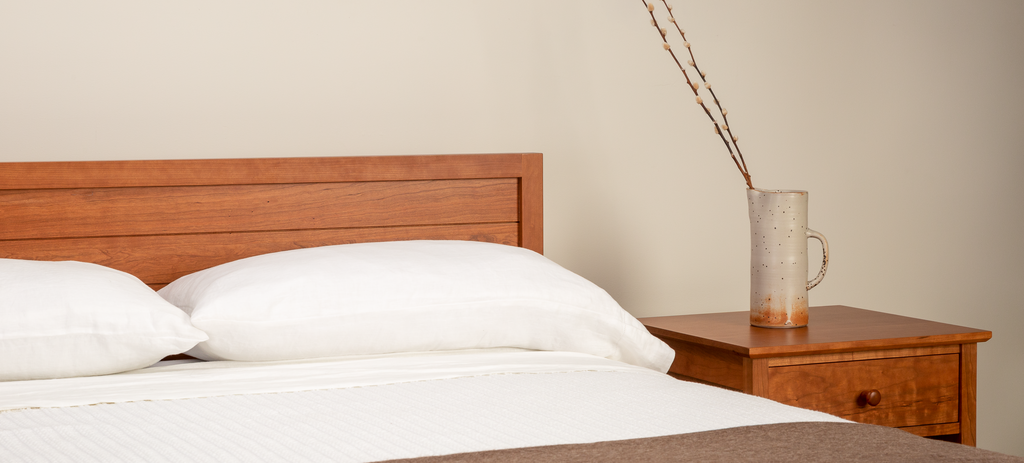Hardwood furniture's authenticity is in part expressed through the unique character of each board milled and selected for use by the craftsman. Natural factors affecting a tree, such as growth, weather, insects and site conditions, can each leave their signature on the wood and tell a rich story of the living material from which each piece of furniture is built. Some examples of interesting features you might observe are described below.
Knots
Knots appear as dark, circular spots on wood that reveal where a branch was once connected to the tree. When otherwise straight surrounding wood grain meets a knot, it weaves its way around the interruption, creating varying grain patterns. There are many classifications of knots, ranging from small pin knots to large knots; those that are tight and sound to those that are loose and unsound. Our woodworkers are able to determine if a knot has weakened the strength of a board or if it is safe to use in furniture construction.


(left) Cluster of pin knots in cherry wood (right) Larger knot in walnut wood
Mineral Deposits


(left) Mineral streak on cherry table top (right) Mineral stain on white oak table top
Minerals absorbed from the soil during a tree’s life will sometimes create mineral deposits that appear as either dark streaks or stains. Mineral streaks are well defined lines, running parallel to the grain. They are found in all woods, but are most noticeable in lighter woods like maple and cherry. A mineral stain, most commonly found in oak species, appears as a blotchy discoloration and can often be visible throughout an entire board.

Mineral streak running down right leg of the Bailey Nightstand. Knots above shelf and pitch pockets, which we discuss more below, on back left leg are also visible.
Pitch Pockets
Not to be confused with mineral deposits, pitch pockets are dark lines or spots that can be as small as pin marks or follow an entire growth ring. The markings are caused by a feeding insect creating a cavity in the tree, that is subsequently filled by sap as the tree continues to grow, resulting in a resin filled pocket. Pitch pockets are common in all woods, but are most frequently found in cherry wood.


(left) Pitch pocket on cherry table top with pen for scale (right) Pitch pocket on side of Mysa nightstand
Heartwood vs. Sapwood
Heartwood and sapwood represent two life stages in the anatomy of a tree trunk. Sapwood is the newest tree growth that is formed in the outermost layer of a tree, just under the bark. This portion contains living cells that conduct water, minerals, and nutrients from the roots up to the canopy. This new growth is often lighter in color and tends to have a high moisture content. Heartwood is the core of a tree, and usually makes up the majority of a cross section. As new growth forms and expands a trees’ diameter, the inner sapwood tissues die and assume a new function of structural support and resistance to microorganisms. Heartwood is often darker in color, caused by extractives that fill the cell walls with organic matter, giving some hardwoods their distinctive rich colors. For a majority of wood species, our woodworkers primarily work with the strong and colorful heartwood, though we do allow a limited amount of sapwood in any given piece. For light colored species, like ash and maple, the sapwood is more desirable.


(left) Visible sapwood on the base of the frame of the Navarend Media Case (right) Triangles of sapwood visible on the side of the Shaker Oval Extensions Table
Grain Variation
Some wood will display moments of specialty figuring, like burl, tigering, and birdseye, creating swirls, twists, ripples and distortions that catch and reflect light in an often desired way. This variation in grain is influenced by many factors including growth rate, location and damage. Spalting is a specific type of figuring, caused by fungus, resulting in random dark tracks in the wood.



(left) Spalted maple live edge headboard (center) Birdseye maple Shaker Boxes (right) Curly maple wood
We do not view these characteristics as flaws, but instead as a sign of authenticity and character. We encourage our craftsmen to allow such variations to make their way into the final product in order to create a unique expression of the natural material and to reduce waste. No characteristics that pass our quality control process will negatively affect the strength of the board or integrity of the final product.


4 comments
This blog is very nice. and very useful to know more understanding about the furniture and their verity.
your blog is very informative and good. I really like your article
Hi Howard. In the past we have offered some furniture pieces in reclaimed wood, but at this moment we do not have any items with that option.
Do you use reclaimed wood?
Leave a comment